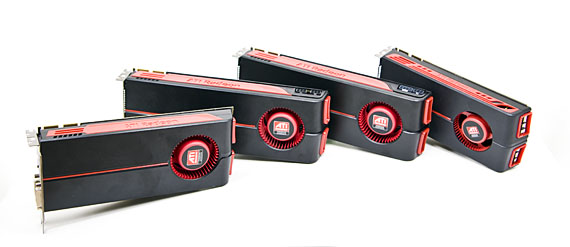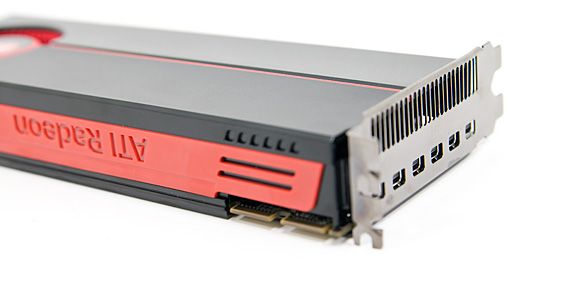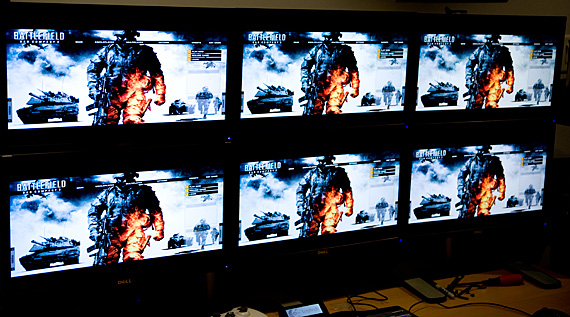AMD's Radeon HD 5870 Eyefinity 6 Edition Reviewed
by Anand Lal Shimpi on March 31, 2010 12:01 AM EST- Posted in
- GPUs
Power Consumption
AMD did list a slight increase in power consumption for the 5870 Eyefinity 6 cards. In real world usage it amounts to a 6 - 7W increase in power consumption at idle and under load. Hardly anything to be too concerned about.
It's worth mentioning that these power numbers were obtained in a benchmark that showed no real advantage to the extra 1GB of frame buffer. It is possible that under a more memory intensive workload (say for example, driving 6 displays) the 5870 E6 would draw much more power than a hypothetical 6-display 1GB 5870.
| Power Consumption Comparison | ||||
| Total System Power |
Radeon HD 5870 1GB
|
Radeon HD 5870 E6 2GB
|
||
| Idle | 179.1W | 186.0W | ||
| Load (Crysis Warhead) | 290.0W | 296.0W | ||
If you are power conscious however, then an Eyefinity 6 setup may not be right for you. Our six 22" Dell displays consumed 114W of power by themselves while playing Crysis. That's the power consumption of an entire Core i5 system under load, just for your displays!
Final Words
I spoke with Carrell Killebrew a few days ago (no, not for the RV970 story) and our conversation drifted over to future applications for GPUs. When Carrell first introduced me to Eyefinity he told me that this was the first step towards enabling a Holodeck-like environment in about 6 years.

Carrell envisions a world where when you want to watch a football game with your friends, or just hang out and play video games you'll do so in a virtual room inside of your home. You'll have a display occupying the majority if not all of your vision. Being displayed will be fully rendered, lifelike models of your friends, which you can interact with in real time. After all, sending model data requires far less bandwidth than exchanging high resolution encoded video between a dozen people in a room.
Sound will have to be calculated on a per person basis. Existing surround sound setups work well for a single user, but not for multiple people spread out all over a virtual room. The GPU will not only have the task of rendering the characters in the room, but also calculating the phase and position accurate sound for everyone.
Today we play games like Rockband or Guitar Hero facing a screen. In Carrell's world, 6 years from now we'll be facing a crowd of fans and it'll look, feel and sound like we're on stage performing. There's a lot that has to be solved between now and then, but in Carrell's eyes this is the beginning. And like most beginnings, this one has its rough patches.
The good news is that a single Radeon HD 5870 Eyefinity 6 Edition card can drive a total of six displays. That's something that we couldn't have imagined from a consumer card even just a couple of years ago. If you've ever found yourself wanting 6 monitors for a particular application, workload or even game - this is your solution.

As a general gaming card however, there are definite issues. In existing titles, with 3 or fewer screens, we just didn't see a tremendous performance advantage to the 5870 E6. The larger frame buffer did help raise minimum frame rates, but not enough to positively impact the average frame rates in our tests. Even in triple display setups we didn't see any reason to get the E6 card.
If you are looking to make the jump to six displays however, the issues then stop being with the card itself and are more about what you want to do with the setup. Having two 3x1 groups makes sense. It's a bit pricey, but it makes sense if you like mixing work and pleasure on your desktop. The single 3x2 group is the problematic configuration. For games you play in the third person, it's great. For first person shooters however, playing on an Eyefinity 6 setup puts you at a disadvantage due to crosshair problem. What AMD really needs to do here is enable a 5x1 configuration for folks serious about FPSes.
The bigger problem is simply the state of game support for Eyefinity. The majority of titles, even new ones coming out today, often ship with gross incompatibilities with Eyefinity setups. AMD is hard at work to make this better, but it means that you can't plop down $1500 for six monitors and two stands, drop another $900 on a pair of video cards and have it work perfectly in everything you'd ever want to play. It's a tough pill to swallow.

If you want to have an immersive gaming experience and if you've got the wall space you're better off buying a 720p projector, building a screen (or painting one on the wall) and calling it a day. On the other hand, of you just need more desktop resolution then a 30" monitor is probably in your future. If you must combine the two needs and have them serviced by a single setup, that's where Eyefinity 6 can offer some value.










78 Comments
View All Comments
fernando.gomes@ydreams.com - Wednesday, March 31, 2010 - link
Hi, Anand.Did you have a chance to try (or ask the AMD guys) about 12 screens? Crossfiring 2 E6 cards makes you wonder about that chance.
I once had a chance to put up a 4x3 screen, 2 years ago, with absolutely no bezel whatsoever, but that set up cost my company an insane amount of money. Each screen cost 7.000$, for starters.
I see this E6 as an alternative to keep an eye on. I couldn't care less about the bezel problems, as my company usually sets up multiscreen displays either with projectors or with bezelless LCD's, but 6 displays might not be enough for our line of work.
So, can it be crossfired to a 12 screen 3D accelerated output ? (I'm not concerned about performance, as our apps usually don't stress GPU's much)
fernando.gomes@ydreams.com - Wednesday, March 31, 2010 - link
When I wrote "a 4x3 screen", I meant "a 4x3 multi-screen display, as per 12 x 720p displays arranged in a 4x3 grid"
PS: damn, we should be able to edit our own posts!
Ryan Smith - Wednesday, March 31, 2010 - link
It can be done. They had it working under Linux using X-Plane back at their September launch. However it's not even close to being in a shipping state, and I don't have the foggiest idea when it would be.fernando.gomes@ydreams.com - Wednesday, March 31, 2010 - link
Thanks for the quick reply, Ryan.Can you tell me how that works, in practice. Now that Windows 7 (and Vista) ditched horizontal spanning, I can't just set my company's apps to 3072x768 (3 screens), because that resolution is not even made available by the driver anymore.
From my previous experiente, I can say that as long I have the taskbar spanned through 3 screens, it is safe to assume that I will be able to accelerate 3D apps at the same resolution as the desktop, at least.
Eyefinity must be somewhat different. If the Catalyst 10.3 is still compliant with WDDM 1.1, then I'm guessing our 3D engine must be 'approved' or at least able to aknowledge the availability of Eyefinity.
Back in the XP days, spanning throug 2 screens was transparent - the 3D app didn't even know it was outputting to 2 or more screens, but with eyefinity, compatibility must be achieved at a much lower level. Is that right?
I'm sorry to bother you, but I don't have access to a hands-on approach.
Thanks,
Fernando
fernando.gomes@ydreams.com - Wednesday, March 31, 2010 - link
I'm sorry for the long post, guys.Shorter version:
- Does the desktop look like XP in Span mode ?(I think I see a taskbar streched along 3 screens, in Anand's video)
- when you run a 3D app (one that is NOT oficially compatible), will 'awkward' resolution (say 5760x2160) be availabe as a choice?
If you answer YES to these 2, then I'm saved, and I'm in trouble aswell, as my company only supports Nvidia (and changing this standard will cost a lot, testing in Quality Assurance will be havoc. Time for a change, I guess. :)
Fernando
Ryan Smith - Wednesday, March 31, 2010 - link
Background info: Eyefinity is the trade name for what AMD calls Single Large Surface technology. SLS operates pretty much as how the name implies: the drivers provide a very large resolution option for applications to work with, and then AMD's hardware takes care of chopping up the image for multiple monitors. Providing the OS/software with a very large resolution is the fundamental aspect behind Eyefinity.So to answer your questions, yes, 3D games see the large resolution. As for the desktop I've never tried it (and Anand currently has all of our Eyefinity gear). To applications/games at least, this is completely transparent. Eyefinity support basically amounts to being able to handle the oddball aspect ratios and the higher resolutions.in the case where resolutions are hard-coded in.
vgdarkstar - Wednesday, March 31, 2010 - link
I would like to point out to all the naysayers of multimon, you stop seeing the bezels after using it for a bit. Do you notice your nose? it's the same effect.Anand Lal Shimpi - Wednesday, March 31, 2010 - link
I agree with that completely which is why I said it wasn't an issue in a 3x1 setup. However in the case of a 3x2 configuration you always notice the bezels in the center of your screen because they often occlude important information (e.g. dialog boxes, crosshairs, etc...).Take care,
Anand
Zstream - Wednesday, March 31, 2010 - link
Why is it that people believe this setup is meant just for gaming? What about people who can have six LCD screens monitoring all sort of devices in a corporate world? What about those who use photoshop and can use other multi-monitor software?Just a thought, not all geeks are gamers you know ;)
Anand Lal Shimpi - Wednesday, March 31, 2010 - link
Oh I agree, and that's why I mentioned dialog boxes as being a problem. Honestly I think the biggest application for a 6-display setup right now is for more than just gaming. It's just a shame that you have to buy a $479 gaming card to enable it :)Take care,
Anand